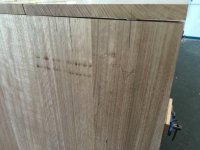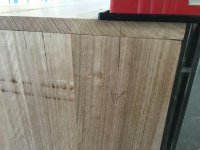Hi all,
I've got a student project (tv stand) that is using 5x30mm dominos to join the top and sides. The glued top doesn't sit flat unless clamped down.
It's got 4 5x30mm dominos along a 500mm length. Do you think the dominos combined with Titebond II will be enough to keep it in place?
I've got a student project (tv stand) that is using 5x30mm dominos to join the top and sides. The glued top doesn't sit flat unless clamped down.
It's got 4 5x30mm dominos along a 500mm length. Do you think the dominos combined with Titebond II will be enough to keep it in place?


